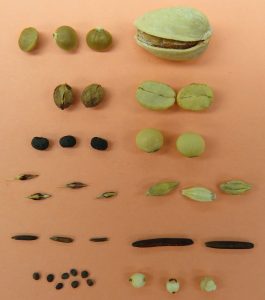Chapter 2 – Crop Domestication
Transformation from Wild Species to Crop Plants
One of the landmarks of human development is the transition from nomadic hunter-gatherer societies to settled agriculture-based societies, the so-called Neolithic Revolution. A key component of this transition was the domestication of wild plant species into cultivated crops capable of supporting higher population densities (Harlan, 1992). Crop domestication from wild species began about 8000 to 10,000 years ago independently in many parts of the world. Some of the more notable centers of domestication were the Fertile Crescent of the Middle East (wheat, barley, lentil, and chickpea), Mesoamerica (maize or corn, chiles, squash, and common bean), the Andean region (potato, tomato, and a second center of origin for common bean), and Southeast Asia (rice, millet, and soybean).

Early farmers selected for traits either deliberately or unintentionally that made the wild plants more suitable for human needs (Figure 1). These included characteristics that improved yield (more or bigger harvested product; reduced branching), made agricultural production easier (loss of seed dormancy; reduced shattering, i.e., greater retention of seed on the plant), or improved product quality (reduced bitterness or toxic properties; easier processing). The term ‘domestication syndrome’ has been used to encompass the collection of traits that were commonly selected (Gepts, 2018).
Many of the domestication traits are characterized by simple inheritance, i.e., they are controlled by one or two genes with large effects rather than by multiple genes. The simple inheritance of domestication traits would have aided their selection and incorporation into wild populations (Gepts, 2018). Domestication most likely occurred over an extended period of time, with ongoing cross-pollination between wild and domesticated populations. Because the selected plants represented just a small fraction of the total wild population, domestication was often accompanied by a reduction of genetic diversity.
videos
In this collage of images (below), click on the video play button to view a short video that demonstrates the domestication of that particular crop plant from its wild ancestors. The video will open in the full image and you can click play to start it. Once you are finished, click on the “X” in the upper right corner to bring you back to the image collage. If you wish to expand the video to fill your entire screen, clicking “Watch On YouTube” will open a new browser window to give you that option. All videos have closed captioning. (Photo credits: Gayle Volk and USDA ARS Image Library)
review
Click through these interactive questions to review the important concepts that were discussed in this chapter.
